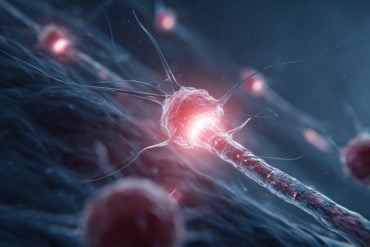Summary: Children diagnosed with ASD at 24 months had differences in visual processing areas of the brain which were apparent at six months of age, a new study reports.
Source: NIH
Infants who were diagnosed with autism spectrum disorder (ASD) at 24 months old had differences in the visual processing areas of the brain that were apparent at 6 months old, according to a study funded by the National Institutes of Health.
The researchers theorized that disruption in visual processing could interfere with how infants see the world around them, changing how they interact with and learn from caregivers and their environment.
These early changes could affect further brain development and play a role in ASD symptoms.
The study was conducted by Jessica Girault, Ph.D., of the University of North Carolina School of Medicine, Chapel Hill, and colleagues. It appears in the American Journal of Psychiatry.
The study enrolled 384 pairs of siblings, the oldest of which had been diagnosed with ASD. Previous research by the team found that younger siblings were more likely to develop ASD if their older siblings had higher levels of ASD traits.
Researchers performed Magnetic Resonance Imaging scans on the brains of the younger siblings at 6, 12 and 24 months of age.

Among the 89 younger siblings who developed ASD, those whose older siblings had severe ASD traits had greater volume and surface area of the cerebrum, which controls speech, thought, emotions, reading, writing, and learning; larger surface area in the part of the visual cortex important for recognizing objects; and less mature connections in the splenium, which connects the brain’s left and right visual cortices and plays a role in visual attention.
Funding: NIH funding was provided by the Eunice Kennedy Shriver National Institute of Child Health and Human Development, National Institute of Mental Health, and National Institute of Neurological Disorders and Stroke.
About this ASD research news
Author: Robert Bock
Source: NIH
Contact: Robert Bock – NIH
Image: The image is in the public domain
Original Research: Open access.
“Infant Visual Brain Development and Inherited Genetic Liability in Autism” by Girault, JB et al. American Journal of Psychiatry
Abstract
Infant Visual Brain Development and Inherited Genetic Liability in Autism
Objective:
Autism spectrum disorder (ASD) is heritable, and younger siblings of ASD probands are at higher likelihood of developing ASD themselves. Prospective MRI studies of siblings report that atypical brain development precedes ASD diagnosis, although the link between brain maturation and genetic factors is unclear. Given that familial recurrence of ASD is predicted by higher levels of ASD traits in the proband, the authors investigated associations between proband ASD traits and brain development among younger siblings.
Methods:
In a sample of 384 proband-sibling pairs (89 pairs concordant for ASD), the authors examined associations between proband ASD traits and sibling brain development at 6, 12, and 24 months in key MRI phenotypes: total cerebral volume, cortical surface area, extra-axial cerebrospinal fluid, occipital cortical surface area, and splenium white matter microstructure. Results from primary analyses led the authors to implement a data-driven approach using functional connectivity MRI at 6 months.
Results:
Greater levels of proband ASD traits were associated with larger total cerebral volume and surface area and larger surface area and reduced white matter integrity in components of the visual system in siblings who developed ASD. This aligned with weaker functional connectivity between several networks and the visual system among all siblings during infancy.
Conclusions:
The findings provide evidence that specific early brain MRI phenotypes of ASD reflect quantitative variation in familial ASD traits. Multimodal anatomical and functional convergence on cortical regions, fiber pathways, and functional networks involved in visual processing suggest that inherited liability has a role in shaping the prodromal development of visual circuitry in ASD.






